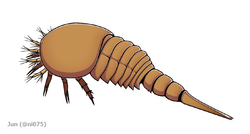Biology:Dibasterium
From HandWiki
Short description: Extinct genus of arthropods
| Dibasterium | |
|---|---|

| |
| Reconstruction of Dibasterium durgae | |
| Scientific classification | |
| Domain: | Eukaryota |
| Kingdom: | Animalia |
| Phylum: | Arthropoda |
| Subphylum: | Chelicerata |
| Clade: | Euchelicerata |
| Genus: | †Dibasterium Briggs et al., 2012 |
| Type species | |
| †Dibasterium durgae Briggs et al., 2012
| |
Dibasterium is an extinct genus of euchelicerate, a group of chelicerate arthropods. Fossils of the single and type species, D. durgae, have been discovered in the Coalbrookdale Formation of the Middle Silurian period (Homerian age) in Herefordshire, England (in the United Kingdom ). The name of the genus is derived from the Latin words dibamos ("on two legs") and mysterium ("mystery"), meaning "mystery on two legs" and referring to its prosomal (of the head) limbs. The species name durgae comes from Durga, a Hindu goddess with many arms.[1][2]
References
- ↑ Dunlop, J. A.; Penney, D.; Jekel, D. (2020). "A summary list of fossil spiders and their relatives". World Spider Catalog. Natural History Museum Bern. pp. 1–296. http://www.wsc.nmbe.ch/resources/fossils/Fossils20.5.pdf.
- ↑ Briggs, Derek E. G.; Siveter, Derek J.; Siveter, David J.; Sutton, Mark D.; Garwood, Russell J.; Legg, David (2012). "Silurian horseshoe crab illuminates the evolution of arthropod limbs". PNAS 109 (39): 15702–15703. doi:10.1073/pnas.1205875109. PMID 22967511. Bibcode: 2012PNAS..10915702B.
Wikidata ☰ Q21354145 entry
 |

